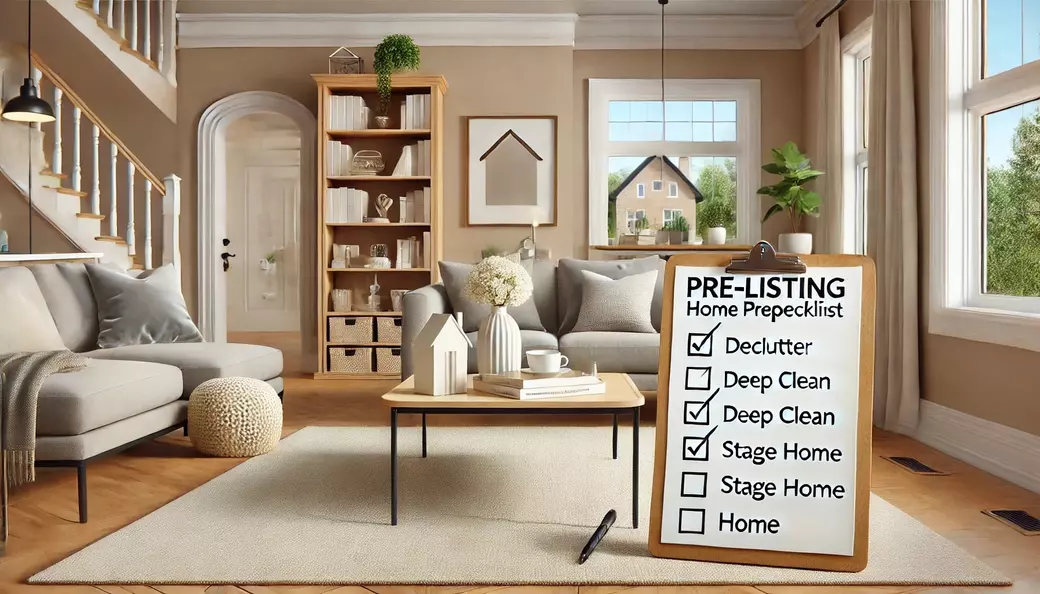Blog > Pre-Listing Home Preparation Checklist: Your Guide to Selling Success
Pre-Listing Home Preparation Checklist: Your Guide to Selling Success
Selling a home is a significant decision, and making a positive first impression is crucial to attracting potential buyers. Before listing your property, taking the time to prepare and enhance its appeal can significantly increase its market value and speed up the selling process. To help you navigate this important step, we’ve created a detailed pre-listing home preparation checklist. By following these guidelines, you can ensure your home is in top condition and ready to make a lasting impression.
1. Decluttering and Deep Cleaning: Creating Space and Order
A clean, clutter-free home is one of the most appealing aspects to potential buyers. When your home feels spacious and organized, it allows buyers to envision their own belongings and lifestyle within the space. Here’s how to achieve that effect:
-
Remove Excess Furniture and Personal Belongings: Start by removing any unnecessary furniture and personal items. This helps create a sense of space and allows buyers to focus on the home’s features rather than distractions. Consider renting a storage unit if needed to temporarily store items you plan to keep.
-
Declutter Closets, Cabinets, and Drawers: Potential buyers often look into closets and cabinets to assess storage space. Decluttering these areas makes them appear more spacious and functional. Aim to keep only essential items, and organize everything neatly.
-
Deep Clean Carpets, Floors, and Surfaces: A thorough cleaning can make your home look fresh and well-maintained. Pay special attention to carpets, hardwood floors, and countertops. If necessary, consider hiring professional cleaners to ensure every nook and cranny is spotless.
-
Organize and Clean Out the Garage: Garages are often overlooked, but a clean and organized garage can be a selling point. Remove any unnecessary items, sweep the floors, and arrange tools or equipment neatly. Buyers appreciate having a functional and tidy space to park their cars or store belongings.
2. Repairs and Maintenance: Fixing What’s Broken
Minor repairs and routine maintenance play a significant role in how buyers perceive your home. A property that shows signs of neglect can deter buyers and potentially lower offers. Addressing these issues beforehand will give buyers confidence in the condition of your home:
-
Fix Leaky Faucets, Dripping Pipes, and Faulty Light Switches: Even small issues like a dripping faucet or a flickering light can raise concerns about overall maintenance. Address these problems to present a well-maintained home.
-
Address Minor Cosmetic Issues: Take care of minor cosmetic issues like chipped paint, cracked tiles, or loose doorknobs. These small repairs can have a big impact on the home’s appearance and can easily be fixed with minimal effort.
-
Consider Larger Upgrades: If your kitchen or bathroom is outdated, consider making some updates. While full renovations can be costly, even small improvements like updating fixtures, replacing countertops, or repainting cabinets can make a big difference.
-
Schedule Maintenance for HVAC Systems and Appliances: Have your heating, ventilation, and air conditioning (HVAC) systems serviced, and ensure all appliances are in good working order. Providing buyers with a list of recent maintenance can add peace of mind.
3. Curb Appeal: Making a Great First Impression
First impressions matter, especially when it comes to selling a home. Curb appeal is the attractiveness of your home from the street, and it’s the first thing potential buyers will notice. Enhancing your curb appeal can create a welcoming vibe and set a positive tone for the rest of the showing:
-
Improve Landscaping: Freshen up your landscaping by adding new mulch, planting colorful flowers, and trimming overgrown bushes. A well-maintained garden can significantly enhance your home’s exterior appeal.
-
Power Wash Walkways, Driveways, and Siding: Over time, dirt and grime can accumulate on exterior surfaces. Power washing walkways, driveways, and siding can give your home a fresh, clean look.
-
Paint Your Front Door: A fresh coat of paint on your front door can make a big difference. Choose a color that complements the overall aesthetic of your home and adds a welcoming feel.
-
Ensure Your Mailbox and House Number Are Clearly Visible: Make sure your mailbox is in good condition and your house number is easy to see from the street. This makes it easier for potential buyers to locate your home and adds to the overall curb appeal.
4. Staging: Showcasing Your Home’s Potential
Staging is the process of arranging furniture and decor to highlight your home’s best features and create an inviting atmosphere. Effective staging can help buyers visualize themselves living in the space, increasing the likelihood of a sale:
-
Depersonalize Your Home: Remove personal items such as family photos, religious items, and personal collections. The goal is to create a neutral space where buyers can imagine their own lives unfolding.
-
Arrange Furniture for Function and Flow: Arrange furniture to create a logical flow that highlights the room's functionality. Use furniture to define spaces, such as creating a cozy reading nook or an inviting dining area.
-
Use Neutral Colors and Accentuate Natural Light: Opt for neutral colors that appeal to a broad audience. Keep window treatments light and open to let in as much natural light as possible, making the space feel bright and airy.
-
Stage Kitchens and Bathrooms: Kitchens and bathrooms are major selling points. Keep these areas clean and clutter-free, with minimal items on countertops. Consider adding fresh flowers or a bowl of fruit for a touch of warmth.
5. Additional Considerations: Final Preparations for Selling
Beyond cleaning, repairs, and staging, there are a few additional steps you can take to ensure your home is ready for the market:
-
Gather All Necessary Paperwork: Before listing your home, gather important documents such as property deeds, title reports, and any permits or warranties related to renovations. Having these documents ready will facilitate a smoother transaction.
-
Schedule Professional Inspections: Consider having a professional inspection done before listing your home. This can help identify any potential issues that might arise during the buyer’s inspection and give you time to address them.
-
Research and Choose a Qualified Real Estate Agent: A skilled real estate agent can make a significant difference in the selling process. Look for an agent with experience in your local market and a proven track record of success. They can provide valuable guidance and marketing expertise.
-
Consider Getting Pre-Approved for a Mortgage: If you’re planning to buy a new home after selling, consider getting pre-approved for a mortgage. This will give you a clear understanding of your budget and streamline the process when you find your next home.
Conclusion: Preparing for Success
Preparing your home before listing it on the market is a crucial step in ensuring a successful sale. By following this comprehensive checklist, you can present your home in the best possible light, attract more potential buyers, and potentially secure a higher selling price. Remember, the effort you put into preparing your home will pay off in the long run, making the entire selling process smoother and more efficient.
If you have any questions or need personalized advice on preparing your home for sale, feel free to contact us. We’re here to help you every step of the way, from pre-listing preparations to closing the deal.

GET MORE INFORMATION

Ian Collins, MBA
Team Lead / Agent | CA DRE# 0202209201858943
Team Lead / Agent CA DRE# 0202209201858943

